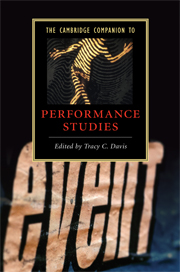Book contents
- Frontmatter
- Introduction: the pirouette, detour, revolution, deflection, deviation, tack, and yaw of the performative turn
- Part I Social polities: history in individuals
- 1 Performance and democracy
- 2 Performance as research: live events and documents
- 3 Movement’s contagion: the kinesthetic impact of performance
- 4 Culture, killings, and criticism in the years of living dangerously: Bali and Baliology
- 5 Universal experience: the city as tourist stage
- 6 Performance and intangible cultural heritage
- Part II Body politics: the individual in history
- Further reading
- Index
2 - Performance as research: live events and documents
from Part I - Social polities: history in individuals
Published online by Cambridge University Press: 28 January 2009
- Frontmatter
- Introduction: the pirouette, detour, revolution, deflection, deviation, tack, and yaw of the performative turn
- Part I Social polities: history in individuals
- 1 Performance and democracy
- 2 Performance as research: live events and documents
- 3 Movement’s contagion: the kinesthetic impact of performance
- 4 Culture, killings, and criticism in the years of living dangerously: Bali and Baliology
- 5 Universal experience: the city as tourist stage
- 6 Performance and intangible cultural heritage
- Part II Body politics: the individual in history
- Further reading
- Index
Summary
The English eighteenth-century diarist James Boswell tells a well-known story about Samuel Johnson that has particular resonance for contemporary notions of performance as research. Boswell writes: “We stood talking for some time together of Bishop Berkeley's ingenious sophistry to prove the non-existence of matter, and that everything in the universe is merely ideal. I observed that, although we were satisfied his doctrine is not true, it is impossible to refute it. I never shall forget the alacrity with which Johnson answered, striking his foot with mighty force against a large stone, till he rebounded from it, “I refute it thus!”” / That instant of low drama as the foot makes contact with the stone is the moment of performance as research. Let us call it, just half-seriously, a dictionary-maker's creative practical experiment in energy exchange between his foot and a stone. One kind of knowledge - theory, philosophy, books, libraries, archives - is challenged profoundly by another. As such, twenty-first-century artist-scholars might consider this a quintessential practice-as-research experiment. But where were its results located? Were they in the stone, in Johnson's body, in the story told by Boswell, in this reflection on its significance, or in some relationship between all four and more?
- Type
- Chapter
- Information
- The Cambridge Companion to Performance Studies , pp. 23 - 45Publisher: Cambridge University PressPrint publication year: 2008
- 6
- Cited by

